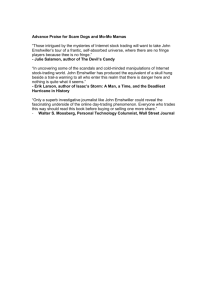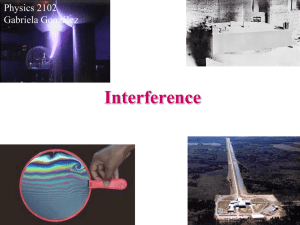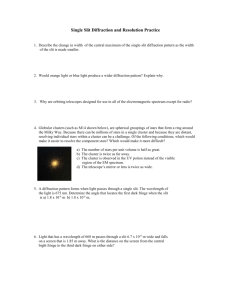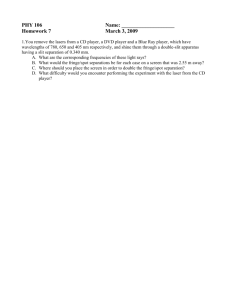GO Added Near-IR Fringe Flats (Rev. A)
advertisement
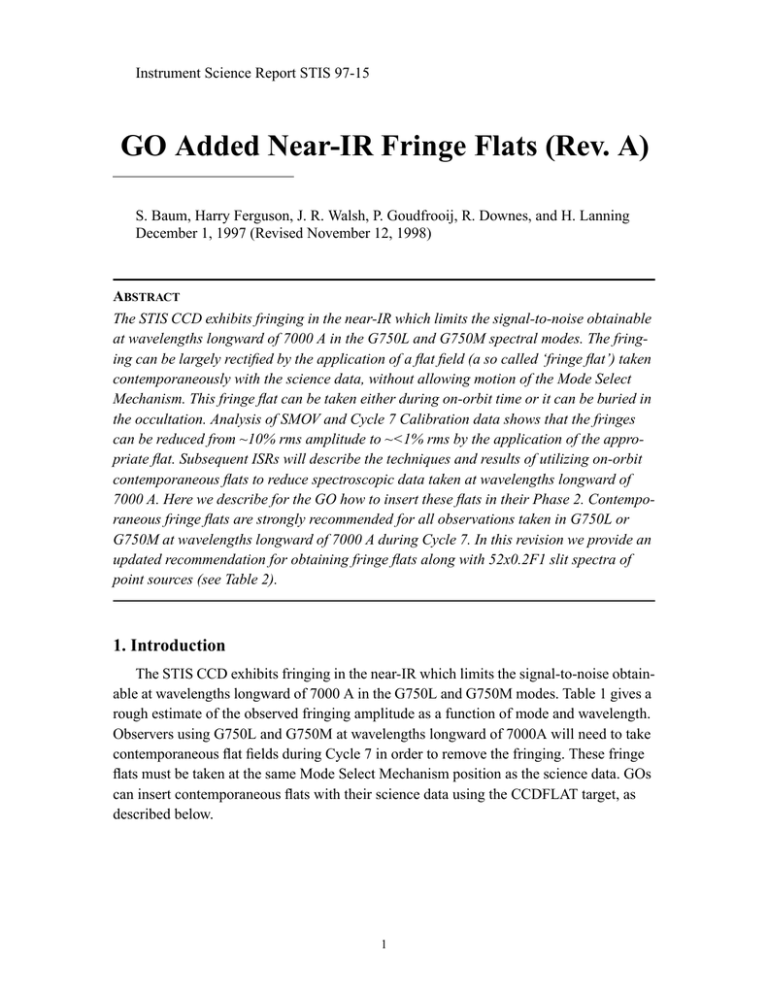
Instrument Science Report STIS 97-15 GO Added Near-IR Fringe Flats (Rev. A) S. Baum, Harry Ferguson, J. R. Walsh, P. Goudfrooij, R. Downes, and H. Lanning December 1, 1997 (Revised November 12, 1998) ABSTRACT The STIS CCD exhibits fringing in the near-IR which limits the signal-to-noise obtainable at wavelengths longward of 7000 A in the G750L and G750M spectral modes. The fringing can be largely rectified by the application of a flat field (a so called ‘fringe flat’) taken contemporaneously with the science data, without allowing motion of the Mode Select Mechanism. This fringe flat can be taken either during on-orbit time or it can be buried in the occultation. Analysis of SMOV and Cycle 7 Calibration data shows that the fringes can be reduced from ~10% rms amplitude to ~<1% rms by the application of the appropriate flat. Subsequent ISRs will describe the techniques and results of utilizing on-orbit contemporaneous flats to reduce spectroscopic data taken at wavelengths longward of 7000 A. Here we describe for the GO how to insert these flats in their Phase 2. Contemporaneous fringe flats are strongly recommended for all observations taken in G750L or G750M at wavelengths longward of 7000 A during Cycle 7. In this revision we provide an updated recommendation for obtaining fringe flats along with 52x0.2F1 slit spectra of point sources (see Table 2). 1. Introduction The STIS CCD exhibits fringing in the near-IR which limits the signal-to-noise obtainable at wavelengths longward of 7000 A in the G750L and G750M modes. Table 1 gives a rough estimate of the observed fringing amplitude as a function of mode and wavelength. Observers using G750L and G750M at wavelengths longward of 7000A will need to take contemporaneous flat fields during Cycle 7 in order to remove the fringing. These fringe flats must be taken at the same Mode Select Mechanism position as the science data. GOs can insert contemporaneous flats with their science data using the CCDFLAT target, as described below. 1 Table 1. Long Wavelength Fringing as function of wavelengtha. Wavelength (A) G750M peak-to-peak G750M rms 5750 1.13 6100 1.21 6600 1.23 6750 1.29 G750L peak-to-peak G750L rms 7250 4.62 1.52 3.18 2.13 7750 9.61 3.10 8.58 3.08 8250 10.53 3.26 6.76 2.80 8750 14.83 3.85 10.81 3.98 9250 27.16 9.00 23.42 7.92 9750 32.09 10.78 25.35 8.96 aThe peak-to-peak amplitude given is determined after the most discrepant points are removed from the flat and is the best measure of the impact of the fringing on science. The rms values at short wavelengths give a good indication of the counting statistics in the flats used for this analysis 2. Designing your Fringe Flat Observations Observers who are observing diffuse sources will typically wish to take their fringe flat utilizing the same slit as they use for their science data. That will give the most similar illumination of the detector by the lamp and the source. However, observers observing point sources will typically fare better if they use a small echelle slit which is concentric with their science slit for their fringe flat, since the flat through that slit will better simulate the source structure. This is important because the PSF of the STIS CCD in the near-IR exhibits a broad halo which contains an appreciable fraction (~20%) of the source flux; these broad wings make the amplitude of the fringing behavior dependent on source structure. The slits supported for science with the G750L and G750M modes and the associated slits to use for diffuse and point source observations in the NIR for fringe flats observations are given in Table 2 below. 2 Table 2. Diffuse Source and Point Source Fringe Flats * supported science slits fringe flat slit for diffuse source observations fringe flat slit for point source observations spectral shift in pixels between science and point source slits 52X2 52X2 0.3X0.09 0.35 52X0.5 52X0.5 0.3X0.09 0.44 52X0.2 52X0.2 0.3X0.09 0.58 52X0.2F1 52X0.2F1 0.3X0.09 and/or*52X0.2F1 0.58 (0.00) 52X0.1 52X0.1 0.2X0.06 0.12 The case of point source observations with the 52X0.2F1 slit is a special case: the 0.3X0.09 slit covers a spatial extent that is only a few pixels larger than the size of the fiducial bar. Hence, we recommend to use the 52X0.2F1 slit for the fringe flats, even for point sources, in case one is interested in the regions further away from the occulted target. Therefore, in summary, Table 3 gives the set of apertures for which fringe flats are supported and their associated slit widths. Table 3. Supported Apertures for Fringe Flats supported apertures for TARGET=CCDFLAT slit width in arcseconds 52X2 2.0 52X0.5 0.5 52X0.2 0.2 52X0.2F1 0.2 52X0.1 0.1 52X0.05 0.05 0.3X0.09 0.09 0.2X0.06 0.06 Supported fringe flats are enabled for the grating modes and central wavelengths given in Table 4 below. All other uses of the Tungsten lamp are restricted and are for engineering use only. In that table we also give the default exposure time for the fringe flat. The default exposure time is chosen to achieve 10,000 electrons/pixel (or signal to noise of 100 per pixel) in the flat over the spectrum in two exposures (i.e., for Number_of_Iterations=2, see below), with the exception of the following wavelength regions. For G750L the shortest wavelengths (less than 5873Α) and the longest wavelengths (longer than 10278Α) will have reduced signal-to-noise. Remember that the pipeline library flat can be used for 3 wavelengths shortward of 7000A. Likewise for the G750M 10363Α and 10871Α settings the signal-to-noise is degraded in the flat, achieving 50:1 for 10363Α and 30:1 for 10871Α. This is because at the shortest wavelengths the Tungsten lamp rapidly loses signal, the longest wavelengths the CCD rapidly loses response, and the ability to remove the fringes even with high signal-to-noise flats is limited by the broad wings of the PSF and the illumination pattern. Table 4. Fringe Flat Parameters Grating Mode Central WavelengthΑ Exposure time in seconds for 52X0.1 slit G750L 7751 25 G750L 8975 25 G750M 6768 90 G750M 7283 80 G750M 7795 80 G750M 8311 85 G750M 8561 85 G750M 8825 70 G750M 9286 60 G750M 9336 50 G750M 9806 85 G750M 9851 90 G750M 10363 300 Inserting Fringe Flats You specify a fringe flat exposure on your RPS2 input as follows. • Specify Target_Name =CCDFLAT to indicate the exposure as a fringe flat. The flat will automatically be taken at GAIN=4, and will utilize two bulbs in the tungsten lamp. • Specify Number_of_Iterations=2 (to allow cosmic ray rejection and assure adequate signal-to-noise). • Specify Config Opmode, Sp_Element and Wavelength. Config must be STIS/CCD Opmode must be ACCUM. Sp_Element and Wavelength must be one of those from Table 4. Specifically, Sp_Element must be G750L and Wavelength 7751 or 8975 or 4 Sp_Element must be G750M and Wavelength one of 6768, 7283, 7795, 8311, 8561, 8825, 9286, 9336, 9806, 9851, 10363. • Specify Aperture. The Aperture must be one of those given in Table 3 (specifically, Aperture=52X2 or 52X0.5 or 52X0.2 or 52X0.2F1 or 52X0.1 or 52X0.05 or 0.3X0.09 or 0.2X0.06. When observing a point source you will want to use the appropriate small echelle slit for your science slit (see Table 2); when observing an extended source you will generally want to utilize the same slit for the flat as for your science data. • Specify Time_Per_Exposure as DEFAULT in seconds. The default exposure time is determined from Table 4 as (column 4 * 0.1) / (slit width in arcseconds * BINAXIS1*BINAXIS2) and assures a signal-to-noise of 100 to 1 per pixel longward of 6000 A and shortward of 1 micron (see above). You may also specify your own exposure time in seconds, but the exposure time must then be shorter than the DEFAULT exposure time for your configuration. • The default is to set Binaxis1=Binaxis2=1, but you can specify Binaxis1=1,2,4 and/or Binaxis2=1,2,4. A few very important points: • Fringe flat exposures are moved into the occulted period by RPS2 whenever they occur as the first or last exposure in an orbit. Thus you can fill the unocculted portion of your orbit with science observations and take the fringe flats during the occultation. • Fringe flats are only effective if taken without a Mode Select Mechanism move between the science exposure and the fringe flat. GOs must assure that they place the fringe flat immediately before or after the science exposure (or a series of science exposures) they wish to rectify. In some cases (for a long series of exposures) you may choose to bracket your science observing with fringe flats to take into account any thermal shifts. An Example For example, if the science for a point source is in the 52X0.1 with G750M/7283, then the required slit is the 0.2X0.06, and the Default exposure time to achieve a signal-tonoise in the flat of 100:1 per pixel is 80*(0.1/0.06)=133 seconds. Thus, the RPS2 file would contain: Exposure_Number: 10 Target_Name: CCDFLAT Config: STIS/CCD Opmode: ACCUM Aperture: 0.2X0.06 Sp_Element: G750M Wavelength: 7283 Number_of_Iterations: 2 Time_Per_Exposure: DEF Note that by placing the flats at the beginning or end of an orbit, the observations will occur in occultation. 5

